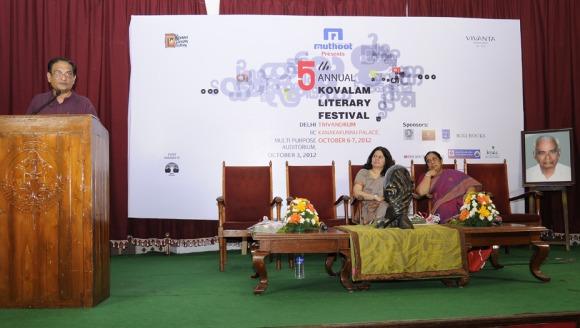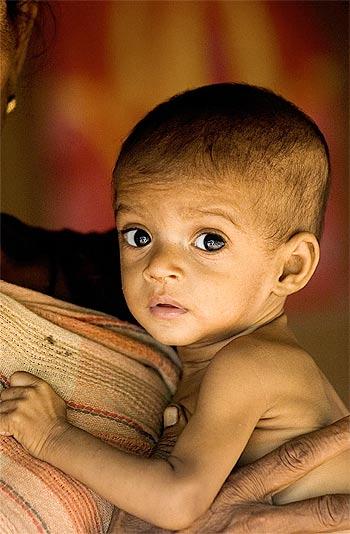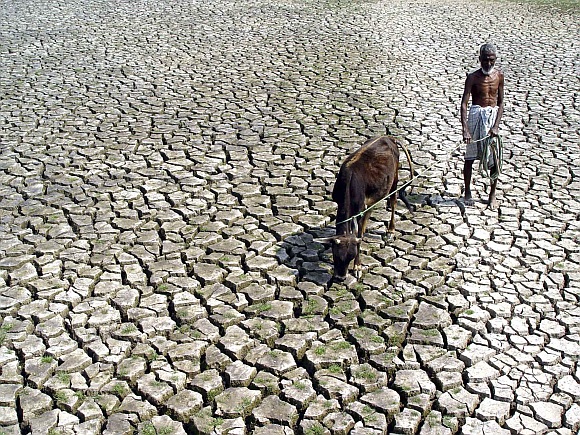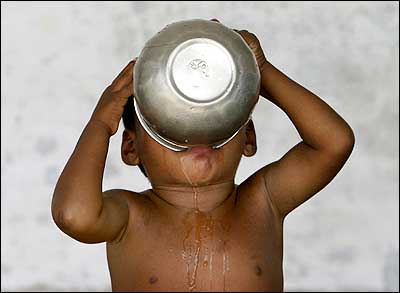 | « Back to article | Print this article |
'Famines perpetrated by policies that privilege the rich'
Many of us have a kind of apocalyptic view of famine, and there is no doubt that, once the stigmata of starvation are revealed, the images haunt you lifelong, says Dr Binayak Sen in his speech at the fifth annual K C John memorial lecture at Kovalam Literary Festival in Trivandrum.
Before we embark on our examination of the coming famine in India, we would do well to look at some recent history -- specifically, at the Bengal famine of 1943. Three million people died in that famine. I heard stories about that famine from my mother, as did many middle class Bengalis of my age. There was no shortage of grain. This is one point I would like to emphasize, because everybody equates famine with a shortage of food, particularly a shortage of grain. There was no shortage of grain in Bengal in 1943, just as there is no shortage of grain in India today -- indeed, there is so much excess grain that the government is hard put to store it so it does not rot.
Amartya Sen has famously analyzed the economics of that famine as "the failure of exchange entitlements"; in other words, those social arrangements, that enabled the people to access the food that they needed, broke down.
Recently a young historian, Madhushri Mukherji, has further extended this analysis. She has shown, on the basis of documentary evidence, in a book called 'Churchill's Secret War' that a racist Winston Churchill made a special direct intervention to ensure that the rice from Bengal was sequestered to feed the British war effort, and then he similarly sequestered the Australian wheat that was supposed to take its place. Finally, in order to forestall a Japanese crossing of the Bay of Bengal from Myanmar -- now in Japanese control -- to Medinipur, he declared a scorched earth policy in Medinipur, destroyed all the grain, and, in order to prevent any riverine transport of grain, burnt all the boats and sank them in the river.
All this in 1943, on the orders of Mr. Churchill. The needs of the army were deliberately privileged over the lives of three million of the Bengal peasantry. The point I am trying to make here is that famines, and, by extension, the other major human rights abuses that go on and on happening in our country and around the world, do not just happen on their own account. They are perpetrated as the result of policies that privilege the rich and powerful, and, by implication, harm the poor and disenfranchised.
Click NEXT to read further...
'Around half of deaths in the under-five age group closely related with poor nutritional status'
While, by and large, this has always been the general order of affairs, for the last twenty years in India we have been functioning in a regime that specifically repudiates the constitutional injunctions for economic justice and equity embodied in the Directive Principles of State Policy, and valorises the argument that having the rich get richer and the poor get poorer is good for the economy, and the way to go forward. An extremely apposite example is provided by Mr. Sharad Pawar, who, at a Cabinet meeting on 14th December 2011, to consider the Food Security Bill, is reported to have said, "How can we feed every mouth in the country? If there is a famine, we will not be able to feed everybody." This is tomfoolery of a piece with the nonsense about 32 rupees and 26 rupees that we have heard elsewhere.
There is one more general point about the definition of famine that I wish to make, before coming to specifics. Amrita Rangasami's (EPW, October 1985) critique of Sen's exchange entitlements approach needs to be taken into account. She says, "The sudden collapse into starvation that has been identified with the famine condition is only the final phase of famine, when the stigmata of starvation become visible, and the victims have collapsed. Famine is not, however, an event marked by the death of the victim. The basic failure in the understanding of famine is the inability to recognize the political, social, and economic determinants that mark the onset of the process. We need, therefore, to redefine famine and identify the various factors -- political, social, psychological and economic -- that operate to keep large classes in the population under continuous pressure."
Many of us have a kind of apocalyptic view of famine, and there is no doubt that, once the stigmata of starvation are revealed, the images haunt you lifelong, as in Jainal Abedin's paintings or the photographs that came out of Biafra. But these images are constructed out of a quotidian reality that would require special insight to perceive as signifying famine.
Reliable and adequately representative anthropometric surveys are difficult to perform and hence difficult to come by. Recently the Nandi Foundation had performed an assessment of children's nutritional status which formed around 44 per cent of all under-five children victims of malnutrition. Prime Minister Mr Manmohan Singh said, while releasing the study report, that it was a "national shame". Of that there is no doubt -- but the shame is familiar. Similar data have been available from the National Nutrition Monitoring Bureau – part of the National Institute of Nutrition (NIN) – for many years, and they are also corroborated by the findings of NFHS – III, carried out in 2005-2006.
Meanwhile, the NHFS - III tells us that around half of all deaths in the under-five age group were closely associated with their poor nutritional status. The CIA World Fact Book puts India's IMR at 46 -- 14th highest in the world, higher than that of every South Asian country except Bangladesh, which is 49. If the CIA says so, it must be true. To put the matter in a world context, every three seconds somewhere around the world, a child dies of causes related to avoidable malnutrition. In those three seconds, the world armaments industry spends $ 1,20,000 in order to keep the system responsible safely in place.
But so far we have been talking only about childhood malnutrition. Often when the talk turns to malnutrition, people assume that it is childhood malnutrition one is talking about. One reason is that sensitive and robust anthropometric measures for adult nutritional status have been in common use for less than twenty years. The Body Mass Index (BMI), which is now in common use, is fairly well standardised both at the individual and community level. It is not applicable to children but only to adults. The BMI is given by dividing the weight in kilograms by the square of the height in metres. The critical value of the BMI is 18.5. Values below 18.5 are indicative of chronic energy deficit i.e. hunger.
Values above 18.5 up to 22 are regarded as normal, and values above 22 (or 23) indicate increasing grades of overweight, or obesity. Pednekar, from Pune, has demonstrated through epidemiological studies that death rates increase as BMI descends below 18.5. If the death rate above 18.5 is taken as unity, then roughly, death rates from 18.5 to 17 are about 1.33, those from 17 to 16 are about 1.5, and BMI values below 16 are associated with a death rate that is double the "normal" death above 18.5. WHO recommendations are that any community that has more than 40% of its members with a BMI below 18.5 should be regarded as a community in famine.
Click NEXT to read further...
'Large sections of India come perilously close to a state of famine'
What are the data regarding adult malnutrition in India today? The National Nutrition Monitoring Bureau (NNMB) is part of the NIN, with headquarters in Hyderabad. The NNMB's latest survey results for ITDA (Integrated Tribal Development Agency) areas, published in 2009, show that 40 per cent of men and 49 percent of women have BMI below 18.5, and can be considered as suffering from chronic hunger; by implication, these areas should be considered famine affected. For the rural areas across the country, and by approximation for the country as a whole, the figures are 33 per cent for men and 36 per cent for women, the pooled figure being 35 per cent.
The same survey shows that 41.9 per cent of subjects from the scheduled tribes (ST) have BMI values below 18.5, and among scheduled castes, 38.4 per cent have values below 18.5. The Sachchar Committee on minorities shows that large proportions of the minority population have BMI values below 18.5. In other words, large sections of the population of India are suffering from chronic energy deficit, and either qualify for, or come perilously close to a state of famine. This famine is not circumscribed in time -- so we have a chronic stable famine that exists over large sections of the Indian population.
The NNMB surveys also show significant anaemia in 55 per cent of the men and 70 per cent of the women, and a diet deficient (in comparison with recommended dietary allowances RDAs) in every nutrient that was measured including Vit. A, Vit. D, B vitamins, Vit. C, and proteins.
Nor is this all. Utsa Patnaik, a senior economist from JNU, has demonstrated declining cereal consumption over a 10 year period – from 1994 to 2004 – so not only do we have chronic energy deficit but the deficit is increasing. These findings are borne out by the findings of the National Sample Survey 2009-2010.
Even more chilling are the implications of the data regarding the epidemiology of Tuberculosis, the paradigmatic hunger associated opportunist infection. My colleagues working in the Jan Swasthya Sahyog in Bilaspur have established a series of about 1000 culture-confirmed cases of tuberculosis, in which there is almost a universal association between pulmonary tuberculosis and BMI below 18.5. Dr Rajeeb Dasgupta of JNU has shown, in the Indian Journal of Community Medicine, that over a period 10 years, the deaths from pulmonary tuberculosis have gone up 5 fold.
So this is the picture at this stage of famine before the stigmata become visible. It must be noted that this state of affairs can and does coexist with an abundance of stored food in the godowns of power. The people who are the victims are able to survive only because of their access to common property resources -- water, land, forest, knowledge of and access to biodiversity.
But under the aegis of the doctrine of eminent domain, the Indian state stands guarantor to a process of expropriation in which all these resources are garnered into the hands of Indian and multinational finance capital. To this end, the state is prepared to deploy all its power -- unarmed when possible, but armed when necessary. As Supreme Court said in Nandini Sundar: tax breaks for the rich and guns for the poor: this is the vision for the future.
Click NEXT to read further...
'Food Security Bill instead of taking us further will take us backwards'
One mitigating factor in this complex picture has been the PUCL Vs Union of India "Right to Food" case, which has been going on for the last 10 years in the Supreme Court in a non-adversarial format. The entire present shape of the PDS in the country is an outcome of the interlocutory orders issued by the Court in this case summarised below.
PDS highlights
Provision of 35kg of grain for every BPL family per month.
Mid day meals for school children.
Supplementary feeding for under- five children.
Supplementary food for pregnant and lactating women.
While the outcome in terms of PDS of the Right to Food case definitely provides some relief, the fact of widespread hunger and its varied manifestations, which we have noted already, shows that this relief is inadequate and uneven. Some of the most "prosperous" areas of the country record high degrees of hunger and malnutrition -- Gujarat and Maharashtra for example.
Moreover, we have already noted Mr Sharad Pawar's caveats about the Food Security Bill. Once this Bill becomes an Act, instead of taking us further towards food security, it will take us several steps backwards. The process of categorisation, which has bedeviled the existing PDS, will be much more complex and liable to misuse in the Act. The amount of grain available may be significantly smaller; moreover the entire process of grain distribution may in the end be replaced by cash transfer systems.
In fact, all these nutritional disabilities, the so-called stigmata of starvation, as I have already pointed out, have been taking place in a regime in which there is an abundance of grain – what is known as the green revolution. This so called revolution is the result of the concentrated subsidised application of exogenous energy in the form of synthetic fertilizers, pesticides, water, and logistical inputs in the form of mechanical tillage, transport and storage, to grow almost exclusively rice and wheat.
This entire effort has resulted in the devastation of our indigenous traditions of low input sustainable agriculture, our millet economy, our rain water harvesting techniques, devastated our soils, and not only exhausted our ground water but contaminated what water there is in the ground with widespread contaminants like arsenic and fluoride. Huge tracts of agricultural and forest land have been diverted to industrial and commercial use, to grow commercial crops like tobacco, ethanol, soya bean for European and American cattle and sugar cane to produce more diabetes in India and abroad. Or, for example, to build fifty-two huge hydro electric dams in the seismically unstable Bramhaputra valley, and, as we are seeing with the Omkareshwar and Indira Sagar dam oustees, with no proper system of rehabilitation in place.
In the era of peak oil, with world oil prices spiralling upward, very soon this kind of subsidized concentrated application of exogenous energy is no longer going to be feasible, let alone profitable. If by that time we have not managed to save our soils, our water economy, our seed systems, our entire culture of growing, storing and equitably distributing food, in sufficient quantity and variety to keep us healthy – that is the famine that is inevitable, and superimposed on the existing situation, the stigmata will be horrendous indeed.
So what is to be done? In the short term we need to modify our Food Security Bill, despite Sharad Pawar's apprehensions, so that everyone can get enough food -- not just cereals, not just wheat and rice, but food -- including pulses and oil -- to keep them well fed and free of the stigmata of starvation. In the longer term, we need to build a popular campaign against useless and harmful agriculture like growing sugarcane, tobacco, alcohol or soya bean. We need to revive our indigenous traditions of growing food, including millets, pulses, GLV or green leafy vegetables, and animal protein to supplement the diet. We need to privilege community based food storage and distribution. And we need to build a society that privileges equity -- in food, of course, but also in living together peacefully.
TOP photo features of the week
Click on MORE to see another set of PHOTO features...




